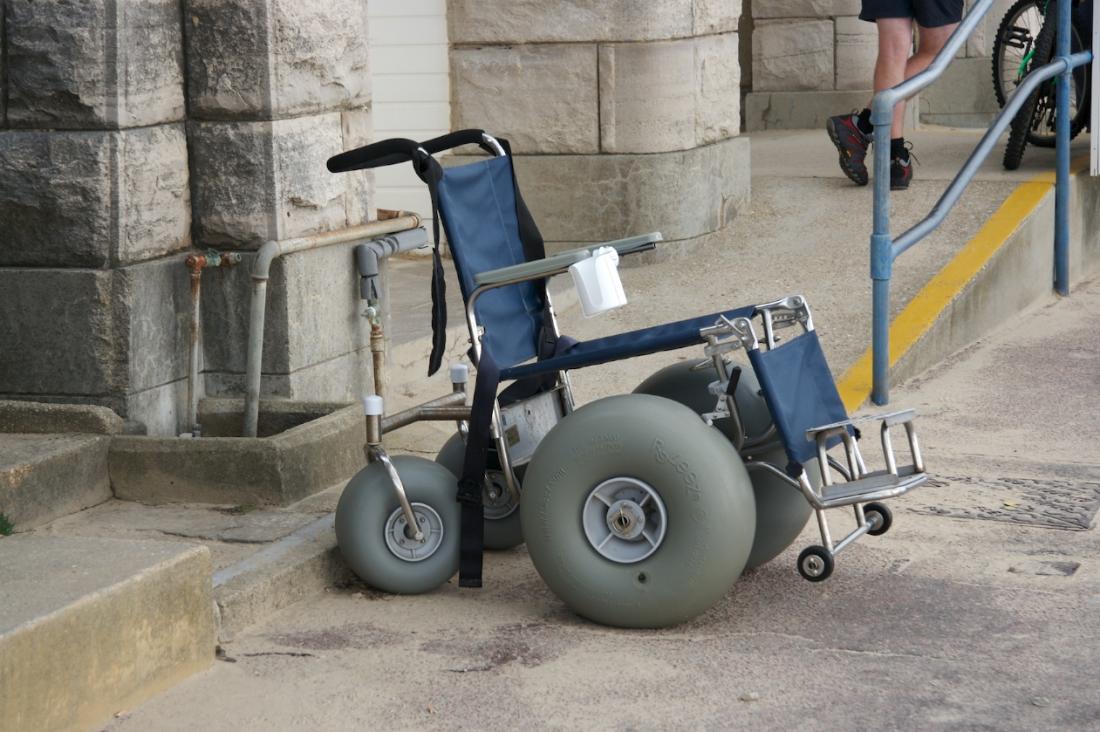Wheelchair
Isolated disabled persons
This earthquake and the tsunami claimed the lives of a large number of persons with disabilities. Elderly persons and children as well as disabled persons are called “vulnerable people in time of disasters,” and in fact, persons with hearing, intellectual, and mental disabilities were slower to access information on the surging tsunami, and furthermore it was difficult for persons with visual disabilities and physically disabled bedridden persons to evacuate on their own even though information reached them. Everybody is placed in a dreadful situation in a time of emergency, and the disabled who had difficulty protecting themselves ended up left out.
Difficulties of the afflicted people with disabilities
Even at evacuation shelters which they reached after escaping the disaster, disabled persons were forced to face many inconveniences due to difficulties moving in wheelchairs and lack of medical equipment, medications, and nursing care products, as well as difficulties communicating with others. Loss of essential utilities including electricity supply threatens the lives of those who depend daily on medical devices such as ventilators and suction devices, or who remain on dialysis. The physical and mental states of those in need of therapies and medications for intractable diseases, internal diseases and mental disorders become unstable, and those who are physically disabled using powered wheelchairs have difficulty moving around. At an early stage, there was a severe shortage of equipment and supplies necessary to sustain life such as supplies for home medical care, beds, and diapers.
Also, survivors had little access to information from the mass media, causing a contradictory situation where the TV audience had more information than the afflicted. People with communication difficulties end up isolated in evacuation shelters packed with a large number of sufferers. Among those who are barely able to go to a restroom because of difficulties moving around, and who are not considered the disabled due to their internal, hearing, language, and mental disorders that are indiscernible to the eye, quite a few people can seldom say what is bothering them in surroundings without familiar faces. Changes in the environment may worsen the condition of a disease for mental reasons, and throw those with a tendency for autism into a panic. Considering that even healthy people feel intense stress, how much anxiety and conflict did disabled persons and their families have at that time?
Support beyond the reach
We, the welfare professionals, build a service network by tapping into the current environment while eliciting intentions of disabled persons in our day-to-day support. Assistance in terms of social welfare is characterized by intervention in an interface between people and the environment and utilization of the interaction. However, this vast disaster devastated even supporters, and disrupted the network which had underpinned their livelihood.
Immediately after the disaster, a great many different public and private support organizations arrived in the affected areas and started providing support. While tangibles such as supplies were delivered to the areas struck by the disaster, there were aspects in which intangible support did not successfully reach the sufferers. The livelihood support we normally provide means having a good grasp of areas and neighborhood where recipients live, and exerting our best efforts in the existing circumstances. In the disaster-stricken areas, however, where the functions of supporting local governments were crippled and the relationships with the supporters involved were severed, there is a limit on whether welfare professionals unfamiliar with these areas are able to demonstrate their full capabilities. It was their major role to heed survivors’ voices during patrols while being escorted by local people who were both sufferers and workers standing up against the disaster.
What to gain from the Great East Japan Earthquake
Responses to the disaster were taken up at the Promotion Committee for Reform of the System for Persons with Disabilities held at the Cabinet Office. The ongoing reform is based on the respect for the human rights of persons with disabilities, and equality with others, and an argument is being developed focusing on ratification of the Convention on the Rights of Persons with Disabilities adopted by the United Nations in 2006. Article 2 of the Convention stipulates “reasonable accommodation” defined as “necessary and appropriate modification and adjustments not imposing a disproportionate or undue burden, where needed in a particular case, to ensure to persons with disabilities the enjoyment or exercise on an equal basis with others of all human rights and fundamental freedoms” (The Japanese version was tentatively translated by the Government of Japan). This disaster posed a question for us regarding what equality means in a time of an emergency disaster situation. Disabled persons need both types of support, i.e., support necessary and common to all survivors and support necessary for disabilities, which should be guaranteed as their right in principle. During the emergency, however, support necessary and common to all survivors was given priority, and there were many cases seen in which disabled persons did not express themselves out of concern that “they would place a heavy burden on others.” With various local governments reviewing their welfare plans for disabled persons now, questions include how much to simulate and what to prepare in light of the lessons learned from this disaster in reexamining approaches to disaster prevention.
Expectation for creation of new support
After the Great Kanto Earthquake in 1923 (Taisho 12), generous donations were raised at home and abroad. Part of these was appropriated for rehabilitation of those who were disabled by the disaster, which ushered in occupational rehabilitation in the area of welfare. At present, acute support regarding the Great East Japan Earthquake has almost terminated, and the stage is about to shift to a mid- and long-term support ranging from years to decades. Such efforts are expected to generate new support measures which go beyond mere disaster support.



